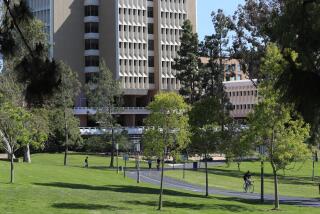Firm Makes Strides in Growing Human Tissue
- Share via
Five years ago, Dr. Gail Naughton, an immunologist at New York University Medical Center, grew frustrated in her laboratory because research models then in use to study the effects of disease on bone marrow failed to replicate real-life conditions.
If bone marrow, the life-giving substance that produces red blood cells, could be grown in the laboratory, Naughton and other doctors could boldly experiment with new treatments without endangering human life.
Then one day, Naughton spotted a roll of nylon mesh lying in the corner of her laboratory and tried using it as “scaffolding” upon which the marrow could grow. The hunch paid off.
“The marrow that we grew on the mesh mimicked marrow found in the body,” said Naughton, who parlayed her discovery into a business venture. She is one of the founders of Marrow-Tech Inc., a San Diego-based biomedical company that grows human cells and tissue.
“We had found the research tool we were looking for and a lot more,” Naughton said. “That’s when the other applications came into the picture.”
Marrow-Tech, which moved its headquarters to San Diego from Elmsford, N.Y, in November, is not generating any revenue, and the introduction of its first product could still be several months away.
But industry analysts say Marrow-Tech and a competing Cambridge, Mass.-based biomedical company called Organogenesis are the pioneers in the tissue-culturing market, which is fast gaining investor interest. So far, the two biomedical companies are the only ones that have developed proprietary means of growing human tissue in a laboratory.
Each company has developed a living skin substitute that can be used as an alternative to using animals to test new products such as cosmetics, chemicals and medicines.
Industry analysts say both companies’ technology could revolutionize medicine if it can be developed to the point of growing more complex living matters such as human organs. Indeed, Marrow-Tech has already begun researching methods of growing the human liver and pancreas.
The company also hopes to use genetically altered tissue to introduce healthy genes into patients suffering from disorders such as hemophilia, high cholesterol and diabetes.
“I think the technology is just plain outstanding,” said Pete Peterson, vice president of research at Hanifen, Imhoff Inc., an investment banking firm in Denver. “Five years down the road (Marrow-Tech) could be producing bone marrow for transplants. Ten years down the road they could be producing organs. They can make a tremendous contribution to medical science. No question.”
Meanwhile, industry analysts say there are plenty of short-term projects to keep Marrow-Tech busy, specifically producing artificially grown skin equivalent to replace animals in determining the toxicity or irritation factor of new chemicals or cosmetics.
“There is an increasing amount of concern expressed by animal activists these days about the use of animals” in toxicity experiments, said Stelios Papadopoulos, managing director of investment banking with New York-based Paine Webber. “They’re concerned about the cruel treatment of animal and are asking, ‘Why not use a skin equivalent?’
“And that’s exactly what Marrow-Tech has created, a biologically derived equivalent,” said Papadopoulos who specializes in biotechnology. “The only difference between the skin they create and the skin that’s on your body is that God created one of them.”
Although it is difficult to determine how much of the $1-billion toxicity test market these companies can capture, Papadopoulos said even a small share would allow the biomedical firms to aggressively pursue other projects.
If successful in reproducing bone marrow, Marrow-Tech could, for example, readily replace a leukemia patient’s bone marrow that has been destroyed by chemotherapy.
Whether producing bone marrow, tissue or human skin, the growing method used by Marrow-Tech in all three cases is essentially the same. A nylon mesh, which serves as a scaffold, is seeded with stroma, which is specialized support cells that help the desired organ cells grow. The desired cells are then sprinkled upon this foundation.
“Using the mesh provided a three-dimensional matrix which allows the cells to orient themselves in space and allows the cells to circulate around one another much like they do in the human body,” said Dr. Ron Cohen, Marrow-Tech’s vice president of clinical and regulatory affairs.
Researchers say such interaction between cells is critical because they believe that chemical signals sent among cells in natural conditions play an important role in fostering growth. “In the past, attempts were made to grow cells in flasks,” Cohen explained. “What happened is that cells would settle down at the bottom of the flask which didn’t allow free flow.”
Using such proprietary technology, Marrow-Tech is developing its skin toxicity kit with Colgate-Palmolive. Marrow-Tech is planning to make the kits commercially available in the second half of 1990.
Organogenesis is now introducing TESTSKIN, its “living skin equivalent” test kit in limited distribution. The kit is being tested by cosmetic giants Avon, Estee Lauder and Mary Kay Cosmetics, according to James Mongiardo, vice president of corporate development. Although privately held Clonetics Corp. of San Diego doesn’t manufacture a living skin equivalent, it does grow and market a variety of human cells. Such cells are sold in test kits, ranging in price from $130 to $295, to conduct tests such as determining toxicity and irritation, said Denise Weiser, director of sales and marketing.
After Dr. Gail Naughton and husband Dr. Brian Naughton, a hematology professor at the Hunter College School of Health Sciences in New York, found success with the nylon mesh, they were eager to develop their finding into usable medical technology.
Unsure about how to introduce their technology to the business community, the two turned to their friend, Herbert Moskowitz, who had dabbled in venture enterprises. Moskowitz raised $1 million in seed money and Marrow-Tech was incorporated in January 1986.
Moskowitz, who was the company’s first chief executive officer, then lured Art Benvenuto, then general manager of pharmaceutical giant Eli Lilly’s Canadian subsidiary, to take over the helm at Marrow-Tech and to take the company public.
In a 1988 initial public offering, Marrow-Tech raised $6 million and added $2 million in private financing in August, 1989. The company now occupies 20,000 square feet of laboratory, manufacturing and office space on Torrey Pines, employing about 30 employees.
Although excited about the company’s early successes, Benvenuto, Marrow-Tech’s chairman, president and chief executive officer, is looking forward to future projects.
“Since we can grow bone marrow, one of the things we talk about that could happen some time in the future is having cell factories where we can grow blood,” Benvenuto said.
More to Read
Inside the business of entertainment
The Wide Shot brings you news, analysis and insights on everything from streaming wars to production — and what it all means for the future.
You may occasionally receive promotional content from the Los Angeles Times.










